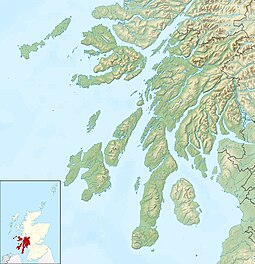Texa
| Gaelic name | Teacsa |
|---|---|
| Meaning of name | Unknown. |
| Location | |
|
Texa shown within Argyll and Bute
|
|
| OS grid reference | NR392437 |
| Coordinates | 55°37′N 6°08′W / 55.61°N 6.14°W |
| Physical geography | |
| Island group | Islay |
| Area | 48 hectares (0.19 sq mi) |
| Area rank | 207 |
| Highest elevation | Ceann Garbh 48 metres (157 ft) |
| Administration | |
| Sovereign state | United Kingdom |
| Country | Scotland |
| Council area | Argyll and Bute |
| Demographics | |
| Population | 0 |
| References | |
Texa (Scottish Gaelic: Teacsa) is a small island 700 metres (0.4 miles) directly south of Islay, in the Inner Hebrides, Scotland. It reaches a height of 48 metres (157 feet) at its highest point, Ceann Garbh. It is part of the parish of Kildalton on Islay. The distilleries of Laphroaig and Lagavulin are nearby on the Islay coast, as well as Port Ellen. It is currently uninhabited, but is home to wild goats, as well as otters.
The island has its own fresh water supply at Tobar Moireig. The rock is mainly schist and some hornblende.
Texa has tentatively been identified as the Oidecha Insula written about by St Adomnan. The etymology of the name is disputed – it may represent either the Old Irish tech (house – taigh in modern Scottish Gaelic) or Oideachd/Oideachas, a word for a religious seminary.
Adomnan mentions that St Cainneach (Kenneth) used "Oidecha Insula" as a stopping place on his journey between Iona and Ireland. Kenneth is said to have left his crozier on Iona on this journey, so St Columba blessed it, cast it into the sea, and it washed up on Oidecha where Kenneth found it.
Whether or not Texa is Oidecha Insula, the island was, like many others round the Scottish coast, used as an ecclesiastical settlement, and the remains of a chapel dedicated to the Virgin Mary can still be seen. This was built, probably on the site of an older one, in the late 14th century by Raghnall/Reginald of Islay, son of Iain/John. This is commemorated today in the name Bàgh na h-Eaglais (Church Bay) and Tobar Moireig ([sic] Mary’s Well), which lies next to the anchorage. There are also many caves on the island, in which anchorites could live.
The shaft of a cross stood east of the chapel, commemorating Raghnall. It is now in a museum in Edinburgh.
...
Wikipedia

